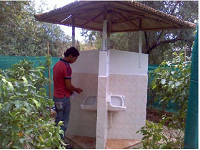/topics/toilets-and-urinals
Toilets and Urinals
A resource book on waterless urinals: an ecological sanitation method that saves water energy and uses urine as a resource
Posted on 22 Nov, 2014 10:30 AM
Waterless urinals (WLU) save water, energy and use urine as resource ( Image courtesy: R Sakthivel)
Green Sanitation Foundation: an NGO in Kolkata develops biotoilets a unique toilet technology
Posted on 22 Nov, 2014 10:30 AMBiotoilets are biological toilets, named so because they convert human waste into non toxic, non contaminating water compatible with environmental standards, through application of multi strain bacteria culture, using aerobic forms of bacteria.
Cost recovery in urban water services : Select experiences in Indian cities A report by Water and Sanitation Program
Posted on 22 Nov, 2014 10:30 AMThe report draws on the report by Water and Sanitation Program (WSP) study from 2008 which made a comparative analysis of 23 urban local bodies (ULBs)—looking at seven cities in detail and another 16 based on secondary data to understand the factors affecting cost recovery.
Water sanitation and health situation in select villages of Nadia district West Bengal
Posted on 22 Nov, 2014 10:30 AMGuest post: Veena Khanduri, India Water Partnership
The Gangetic river basin in Eastern India receives heavy monsoon rainfall, much higher than the rest of India. Nonetheless, the region suffers from both the problem of year round water availability as well as poor quality of drinking water. Due to excessive exploitation, the groundwater aquifers in the region have been depleting alarmingly, surface water is highly limited & poorly maintained and consequently cannot count up as a major source of safe drinking water.
Report on Greening of the NRDWP News and Policy Update from India WASH Forum eNewsletterDec 2012
Posted on 22 Nov, 2014 10:30 AM Gender in WASH: Misplaced perspective in WASH sector
Gender in WASH: Misplaced perspective in WASH sector
An analysis of 2011 census data on household amenities with respect to drinking water sources and latrine facilities in urban areas of the country A document by CPHEEO Ministry of Urban Development
Posted on 22 Nov, 2014 10:30 AMThis document by Central Public Health and Environmental Engineering Organisation , Ministry of Urban Development, is an analysis of 2011 census data on of the drinking water and latrine facilities in urban areas of the country.
Arghyam prepares Water Quality Management WQM framework for rural areas Ministry of Drinking Water and Sanitation releases its first enewsletter on water and sanitation in India December 2012
Posted on 22 Nov, 2014 10:30 AMThe newsletter refers to the nationwide campaign carried out by Arghyam, with the aim of creating awareness on water quality issues with a specific focus on fluoride contamination in groundwater sources, by engaging students from across the country in a water quality testing, analysis, and reporting.
In the newsletter, the spotlight is turned on:
Hackers stay up day and night at the Pune Sanitation Hackathon in December 2012 to develop innovative software solutions that address challenges facing the sanitation sector in India
Posted on 22 Nov, 2014 10:30 AM
The Sanitation Hacakathon challenged programmers to develop innovative software solutions that address real-world problems in sanitation. Technologists teamed up with sanitation subject experts in an intensive marathon to find innovative solutions to challenges facing the sanitation sector.
Problem definitions






